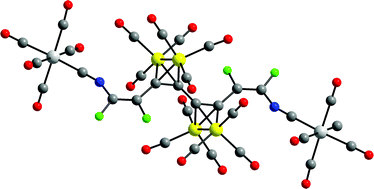Syntheses of highly unsaturated isocyanidesvia organometallic pathways†
Abstract
The carbon carbon ![[double bond, length as m-dash]](https://www.rsc.org/images/entities/char_e001.gif) CF2) 1 by lithium or Grignard compounds 2a–i yields the isocyanide complexes (CO)5Cr(CN–CF
CF2) 1 by lithium or Grignard compounds 2a–i yields the isocyanide complexes (CO)5Cr(CN–CF![[double bond, length as m-dash]](https://www.rsc.org/images/entities/char_e001.gif) CF–R) 3a–i (a R = CH
CF–R) 3a–i (a R = CH![[double bond, length as m-dash]](https://www.rsc.org/images/entities/char_e001.gif) CH2, b R = CH
CH2, b R = CH![[double bond, length as m-dash]](https://www.rsc.org/images/entities/char_e001.gif) CF2, c R = C
CF2, c R = C![[triple bond, length as m-dash]](https://www.rsc.org/images/entities/char_e002.gif) CH, d R = C
CH, d R = C![[triple bond, length as m-dash]](https://www.rsc.org/images/entities/char_e002.gif) C–SiMe3, e R = C
C–SiMe3, e R = C![[triple bond, length as m-dash]](https://www.rsc.org/images/entities/char_e002.gif) C–Ph, f R = C
C–Ph, f R = C![[triple bond, length as m-dash]](https://www.rsc.org/images/entities/char_e002.gif) C–C6F4OMe, g R = C
C–C6F4OMe, g R = C![[triple bond, length as m-dash]](https://www.rsc.org/images/entities/char_e002.gif) C–C6H3(CF3)2, h R = C6F5, i R = C6H3(CF3)2) as mixtures of E and Z isomers. The dinuclear complexes 5a–c are obtained from the reaction of 1 with the dilithio or dimagnesium compound 4a–c as the Z,Z-, E,Z- and E,E-isomers, respectively. (CO)5Cr(CN–CF
C–C6H3(CF3)2, h R = C6F5, i R = C6H3(CF3)2) as mixtures of E and Z isomers. The dinuclear complexes 5a–c are obtained from the reaction of 1 with the dilithio or dimagnesium compound 4a–c as the Z,Z-, E,Z- and E,E-isomers, respectively. (CO)5Cr(CN–CF![[double bond, length as m-dash]](https://www.rsc.org/images/entities/char_e001.gif) CF–C
CF–C![[triple bond, length as m-dash]](https://www.rsc.org/images/entities/char_e002.gif) C–C
C–C![[triple bond, length as m-dash]](https://www.rsc.org/images/entities/char_e002.gif) C–CF
C–CF![[double bond, length as m-dash]](https://www.rsc.org/images/entities/char_e001.gif) CF–NC)Cr(CO)57 is obtained as a mixture of Z,Z-, Z,E- and E,E-isomers from (CO)5Cr(CN–CF
CF–NC)Cr(CO)57 is obtained as a mixture of Z,Z-, Z,E- and E,E-isomers from (CO)5Cr(CN–CF![[double bond, length as m-dash]](https://www.rsc.org/images/entities/char_e001.gif) CF–C
CF–C![[triple bond, length as m-dash]](https://www.rsc.org/images/entities/char_e002.gif) C–H 3d by Eglington-
C–H 3d by Eglington-![[double bond, length as m-dash]](https://www.rsc.org/images/entities/char_e001.gif) CF–C
CF–C![[triple bond, length as m-dash]](https://www.rsc.org/images/entities/char_e002.gif) C–CF
C–CF![[double bond, length as m-dash]](https://www.rsc.org/images/entities/char_e001.gif) CF–NC)Cr(CO)56 and (CO)5Cr(CN–CF
CF–NC)Cr(CO)56 and (CO)5Cr(CN–CF![[double bond, length as m-dash]](https://www.rsc.org/images/entities/char_e001.gif) CF–C
CF–C![[triple bond, length as m-dash]](https://www.rsc.org/images/entities/char_e002.gif) C–C
C–C![[triple bond, length as m-dash]](https://www.rsc.org/images/entities/char_e002.gif) C–CF
C–CF![[double bond, length as m-dash]](https://www.rsc.org/images/entities/char_e001.gif) CF–NC)Cr(CO)57 react with octacarbonyldicobalt forming the cluster compounds Z,Z-[{η2-μ2-(CO)5Cr(CN–CF
CF–NC)Cr(CO)57 react with octacarbonyldicobalt forming the cluster compounds Z,Z-[{η2-μ2-(CO)5Cr(CN–CF![[double bond, length as m-dash]](https://www.rsc.org/images/entities/char_e001.gif) CF–C
CF–C![[triple bond, length as m-dash]](https://www.rsc.org/images/entities/char_e002.gif) C–CF
C–CF![[double bond, length as m-dash]](https://www.rsc.org/images/entities/char_e001.gif) CF–NC)Cr(CO)5}Co2(CO)6] Z,Z-8, E,Z-[{η2-μ2-(CO)5Cr(CN–CF
CF–NC)Cr(CO)5}Co2(CO)6] Z,Z-8, E,Z-[{η2-μ2-(CO)5Cr(CN–CF![[double bond, length as m-dash]](https://www.rsc.org/images/entities/char_e001.gif) CF–C
CF–C![[triple bond, length as m-dash]](https://www.rsc.org/images/entities/char_e002.gif) C–CF
C–CF![[double bond, length as m-dash]](https://www.rsc.org/images/entities/char_e001.gif) CF–NC)Cr(CO)5}Co2(CO)6] E,Z-8 and E,E-[{η2-μ2-(CO)5Cr(CN–CF
CF–NC)Cr(CO)5}Co2(CO)6] E,Z-8 and E,E-[{η2-μ2-(CO)5Cr(CN–CF![[double bond, length as m-dash]](https://www.rsc.org/images/entities/char_e001.gif) CF–C
CF–C![[triple bond, length as m-dash]](https://www.rsc.org/images/entities/char_e002.gif) C–CF
C–CF![[double bond, length as m-dash]](https://www.rsc.org/images/entities/char_e001.gif) CF–NC)Cr(CO)5}Co2(CO)6] E,E-8 and Z,Z-[{η2-μ2-(CO)5Cr(CN–CF
CF–NC)Cr(CO)5}Co2(CO)6] E,E-8 and Z,Z-[{η2-μ2-(CO)5Cr(CN–CF![[double bond, length as m-dash]](https://www.rsc.org/images/entities/char_e001.gif) CF–C
CF–C![[triple bond, length as m-dash]](https://www.rsc.org/images/entities/char_e002.gif) C–C
C–C![[triple bond, length as m-dash]](https://www.rsc.org/images/entities/char_e002.gif) C–CF
C–CF![[double bond, length as m-dash]](https://www.rsc.org/images/entities/char_e001.gif) CF–NC)Cr(CO)5}{Co2(CO)6}2] Z,Z-9, E,Z-[{η2-μ2-(CO)5Cr(CN–CF
CF–NC)Cr(CO)5}{Co2(CO)6}2] Z,Z-9, E,Z-[{η2-μ2-(CO)5Cr(CN–CF![[double bond, length as m-dash]](https://www.rsc.org/images/entities/char_e001.gif) CF–C
CF–C![[triple bond, length as m-dash]](https://www.rsc.org/images/entities/char_e002.gif) C–C
C–C![[triple bond, length as m-dash]](https://www.rsc.org/images/entities/char_e002.gif) C–CF
C–CF![[double bond, length as m-dash]](https://www.rsc.org/images/entities/char_e001.gif) CF–NC)Cr(CO)5}{Co2(CO)6}2] E,Z-9 and E,E-[{η2-μ2-(CO)5Cr(CN–CF
CF–NC)Cr(CO)5}{Co2(CO)6}2] E,Z-9 and E,E-[{η2-μ2-(CO)5Cr(CN–CF![[double bond, length as m-dash]](https://www.rsc.org/images/entities/char_e001.gif) CF–C
CF–C![[triple bond, length as m-dash]](https://www.rsc.org/images/entities/char_e002.gif) C–C
C–C![[triple bond, length as m-dash]](https://www.rsc.org/images/entities/char_e002.gif) C–CF
C–CF![[double bond, length as m-dash]](https://www.rsc.org/images/entities/char_e001.gif) CF–NC)Cr(CO)5}{Co2(CO)6}2] Z,Z-9, respectively. The crystal and molecular structures of E-3d, Z-3h, Z,Z-8, E,Z-8 and Z,Z-9 were elucidated by single-crystal
CF–NC)Cr(CO)5}{Co2(CO)6}2] Z,Z-9, respectively. The crystal and molecular structures of E-3d, Z-3h, Z,Z-8, E,Z-8 and Z,Z-9 were elucidated by single-crystal


 Please wait while we load your content...
Please wait while we load your content...